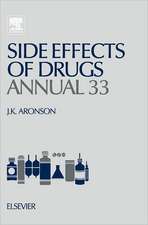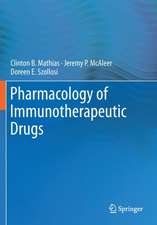Strategies to Modify the Drug Release from Pharmaceutical Systems
Autor Marcos Luciano Bruschien Limba Engleză Hardback – 11 iun 2015
- Addresses the principles, systems, applications and advances in the field of drug delivery
- Highlights the mathematical and physicochemical principles related to strategies
- Discusses drug release and its possible modifications
Preț: 842.14 lei
Preț vechi: 925.43 lei
-9% Nou
Puncte Express: 1263
Preț estimativ în valută:
161.16€ • 174.100$ • 135.38£
161.16€ • 174.100$ • 135.38£
Carte tipărită la comandă
Livrare economică 16-30 aprilie
Preluare comenzi: 021 569.72.76
Specificații
ISBN-13: 9780081000922
ISBN-10: 0081000928
Pagini: 208
Dimensiuni: 156 x 234 x 23 mm
Greutate: 0.5 kg
Editura: ELSEVIER SCIENCE
ISBN-10: 0081000928
Pagini: 208
Dimensiuni: 156 x 234 x 23 mm
Greutate: 0.5 kg
Editura: ELSEVIER SCIENCE
Cuprins
Chapter 1 - General considerations
Pharmaceutics: Safety, quality and efficacy
Conventional and alternative therapeutic regimens
Chapter 2 - Modification of drug release
Objectives
Advantages
Disadvantages
History
Chapter 3 - Classification of therapeutic systems for drug delivery
Passives, pre-programmed
Actives, programmed and controlled externally
Actives, self-programmable
Chapter 4 - Main mechanisms to control the drug release
Diffusion
Swelling
Erosion
Osmosis
Others
Chapter 5 - Mathematical and physicochemical models of drug release
Chapter 6 - Drug delivery systems: Principles, local of administration, materials, characterization, applications, advances and the use of natural products
Matrix Tablets
Suspensions
Osmotic Pumps
Micro/nanoparticles
Micro/nanoemulsioned systems
Liposomes and niosomes
Floating Systems
Systems with cyclodextrins
Transdermal systems
Bio/mucoadhesive Systems
Liquid crystalline systems
Implant
Biocompatible carriers
Other systems
Pharmaceutics: Safety, quality and efficacy
Conventional and alternative therapeutic regimens
Chapter 2 - Modification of drug release
Objectives
Advantages
Disadvantages
History
Chapter 3 - Classification of therapeutic systems for drug delivery
Passives, pre-programmed
Actives, programmed and controlled externally
Actives, self-programmable
Chapter 4 - Main mechanisms to control the drug release
Diffusion
Swelling
Erosion
Osmosis
Others
Chapter 5 - Mathematical and physicochemical models of drug release
Chapter 6 - Drug delivery systems: Principles, local of administration, materials, characterization, applications, advances and the use of natural products
Matrix Tablets
Suspensions
Osmotic Pumps
Micro/nanoparticles
Micro/nanoemulsioned systems
Liposomes and niosomes
Floating Systems
Systems with cyclodextrins
Transdermal systems
Bio/mucoadhesive Systems
Liquid crystalline systems
Implant
Biocompatible carriers
Other systems

























